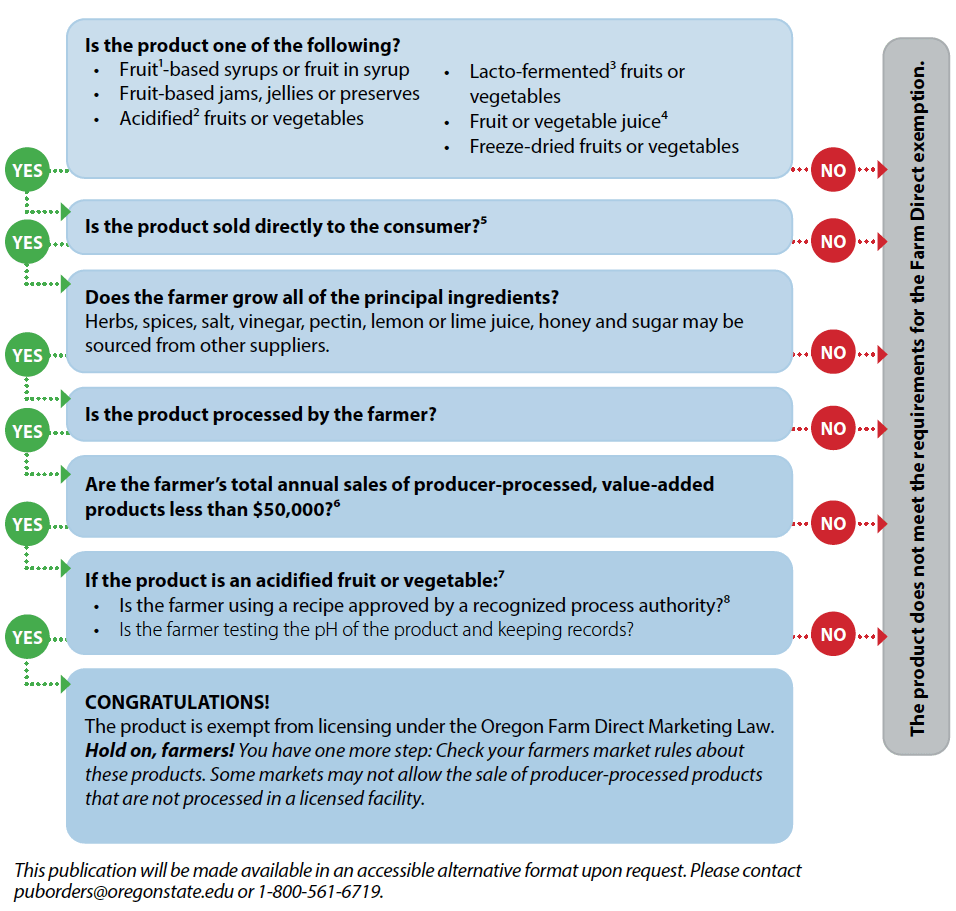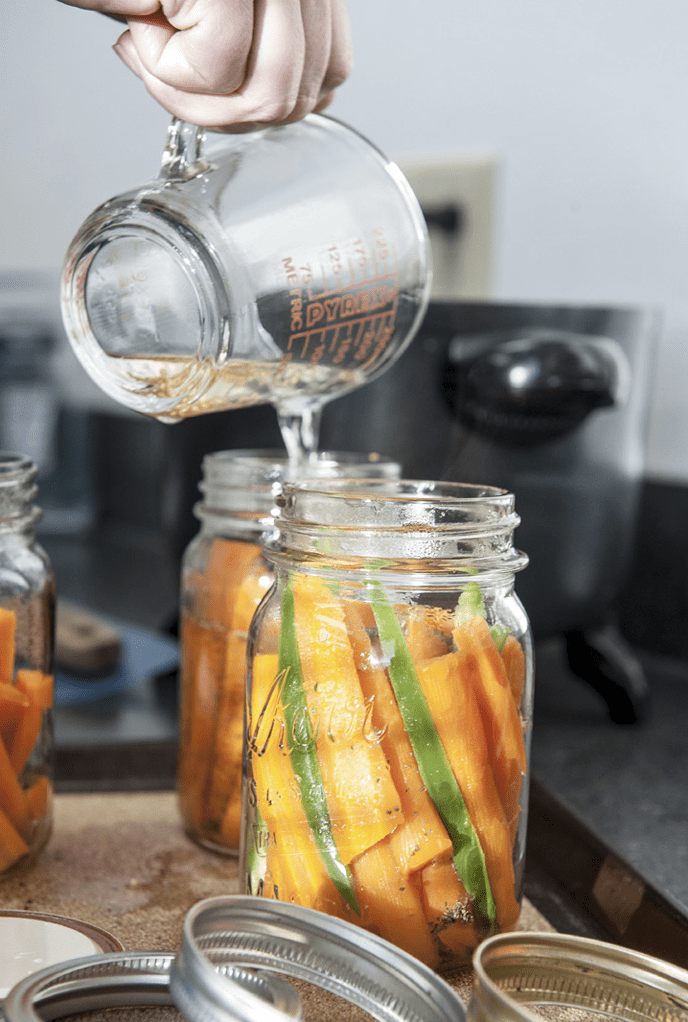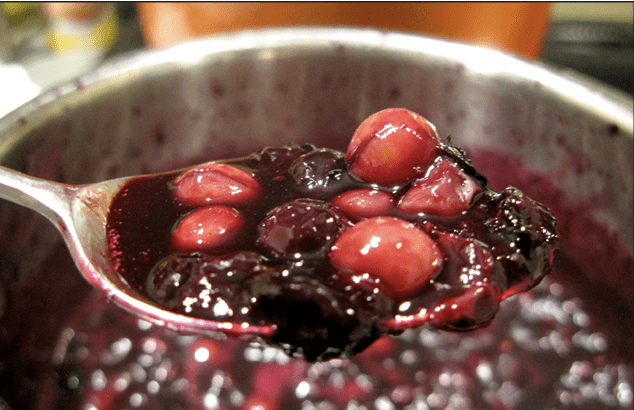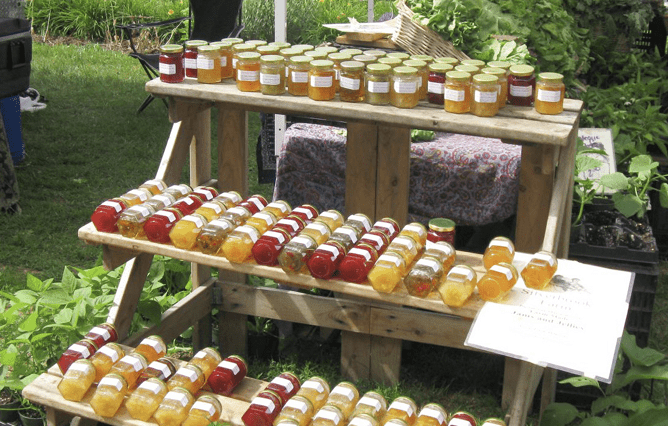Oregon’s Farm Direct Marketing Law allows farmers to turn what they grow into low-risk, value-added products like jams and pickles, and to sell them directly to consumers without being licensed food processors. That sentence — like the law itself — has a lot of detail packed into it. This short guide unpacks those details for farmers and farmers market managers. (It’s useful for other people, too.) Use this flow chart to determine whether a product qualifies for Farm Direct sales. Then read on for more information.
Additional resources
Make sure the product label has all the required info!
- Product identity.
- Name of agricultural producer.
- Address of agricultural producer.
- Net weight.
- List of ingredients (including any major allergens).
- The following notifications:
- “THIS PRODUCT IS HOMEMADE AND IS NOT PREPARED IN AN INSPECTED FOOD ESTABLISHMENT.”
- “NOT FOR RESALE.”
Acidic fruit and vegetable juices that have not received a 5-log reduction of the most resistant microorganism of public health significance must include the following warning statement:
WARNING: This product has not been pasteurized and therefore may contain harmful bacteria that can cause serious illness in children, the elderly and persons with weakened immune systems. Keep refrigerated.
Recordkeeping
Sales records are required for all value-added products sold under the exemption. Sales records must include the product(s) sold, price, quantity sold and a current rolling total of year-to-date sales.
Additional records are required for each batch of acidified foods. These records must include the recipe source, processing times and procedure, date, and finished equilibrium pH value. If an electronic pH meter is used, it must be calibrated, and pH meter calibration records must be maintained.
Additional processing and production records are required for dried or cured fruits, vegetables, edible flowers, herbs or herb blends, and herbal teas, for which drying or curing is not part of routine post-harvest handling. These records can include air temperature, processing times, conditioning outcome, etc. Recording water activity (Aw) is not required.
Copies of all records must be maintained and kept available for the Oregon Department of Agriculture for a period of three years.
pH testing
pH meter calibration records and equilibrium pH measurement records are required for each batch of acidified food.
If the pH of the product is 4.0 or lower, colorimetric methods such as litmus paper may be used. However, pH litmus paper may not work well with some colored products.
If the pH of the product is between 4.0 and 4.6, a pH meter with a minimum accuracy of ± 0.01 to 0.02 pH must be used.
Naturally acidic foods like fruit jams and jellies are not required to be pH tested, but they must have a pH of 4.6 or below. When in doubt, farmers can take pH measurements to verify that the product is acidic.
Certain fruits and vegetables, such as persimmons, Asian pears and tomatoes, are borderline acidic, and products made from them should be pH tested to ensure safety.
See video instructions for pH testing an acidified food at pH Meter Calibrating and Testing for Pickled Food Products.
Examples of producer-processed products not allowed under the Farm Direct Agricultural Marketing Law
(This list is not exhaustive)
- Any product with animal protein (for example, meat, fish, dairy, eggs).
- Kombucha.
- Frozen fruits and vegetables.
- Apple cider vinegar.
If you are unsure your product qualifies, contact the Oregon Department of Agriculture Food Safety Division.
Other products allowed under the Farm Direct Agricultural Marketing Law
All products must be grown and processed by the farmer.
- Fruits, vegetables, herbs (fresh and dried).
- Legumes and seeds (fresh and dried).
- Grains (whole, cracked or ground).
- Uncooked parched or roasted grains.
- Nuts (shelled and unshelled).
- Flour.
- Shell eggs.
- Honey, no additives.
- Maple and walnut syrup.
The following products are also allowed as long as they are prepared on-site, not intended for immediate consumption and are packaged to take home:
- Popped popcorn.
- Roasted nuts.
- Roasted peppers.
- Roasted corn-on-the-cob.
Oregon Department of Agriculture FAQs about farm direct
Where to find approved recipes and check yours
ODA recognizes the following references as providing approved processes and formulations (recipes) for acidified products sold under the Farm Direct exemption:
- USDA Complete Guide to Home Canning
- So Easy to Preserve, from the University of Georgia Cooperative Extension
- Pacific Northwest Extension Food Preservation publications
Farmers may also submit a copy of the recipe — including the product ingredients list, directions, formulation, and thermal processes used — to a recognized authority for approval. Contact the OSU Department of Food Science and Technology for more information.
Next steps if products don't qualify for farm direct
Value-added products not covered under the Farm Direct exemption — including products made from recipes not listed by an approved source or with ingredients not grown by the farmer — must be made in a licensed facility. There are four options for processing in a licensed facility.
- Obtain a domestic kitchen license.
- Build a commercial food processing facility.
- Rent space in a commercial or commissary kitchen. This is a good alternative to building your own facility. Search online for “commercial kitchens for rent.” Keep in mind that you must still obtain your own food-processing license. Contact your local ODA food safety specialist for more information.
- Use a local food processor (also known as a co-packer) who will make, package and label your product for you in their licensed facility following an approved recipe. Contact OSU’s Food Innovation Center at 503-872-6680 for a list of co-packers.
For more information about licensing requirements for domestic kitchens and commercial facilities, and to find your local ODA food safety specialist, see the ODA Food Safety Program.
Note
This document should be regarded strictly as a supplement to the Oregon Farm Direct Marketing Rules and should never be considered a substitute to reading and understanding the regulations. For a complete list of requirements, please consult OAR 603-025-0215 through 603-025-0275.




